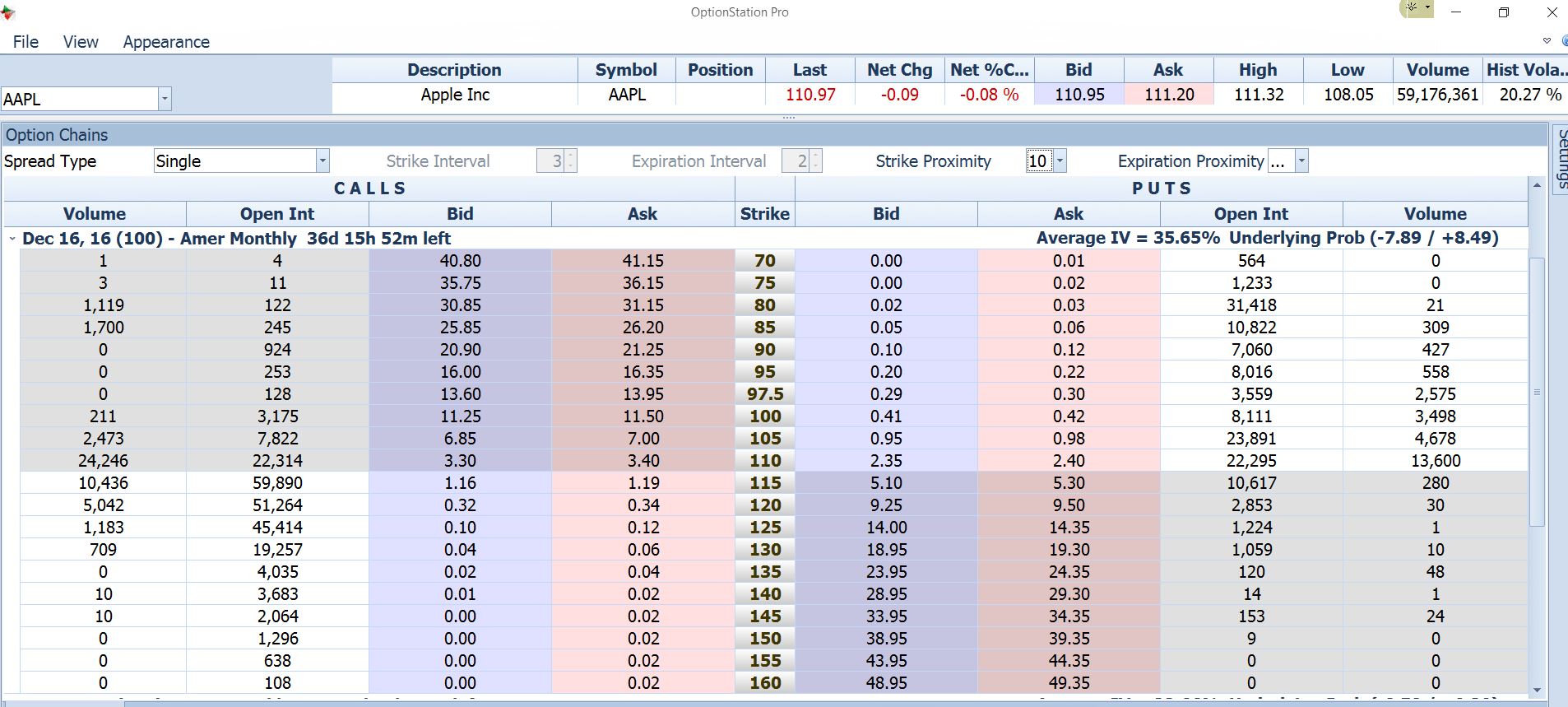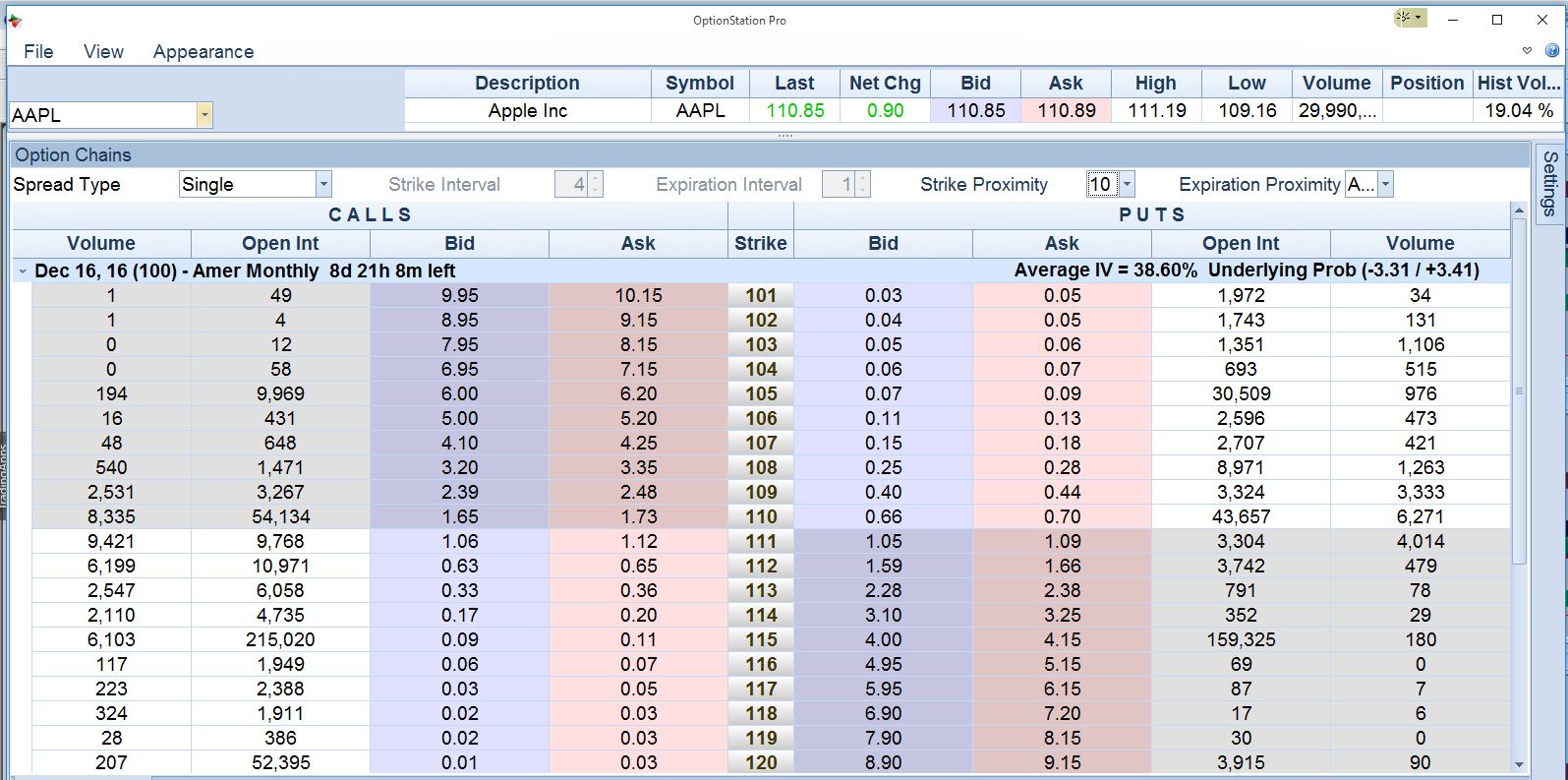In a recent article, I described some basic features of put and call options. I noted that these can be used to protect stock that you have; or to make money from movement in a stock that you don’t have (up or down), or even to make money from a lack of movement of a stock.
Today we’ll take that explanation a little further, concentrating on the idea of making money from a stock that does not move.
If you’re completely unfamiliar with options, I suggest clicking on the link above for the bare basics first.
I used the stock of Apple as my example previously. Here is what a small part of Apple’s option chain (list of available options) looked like on November 9, 2016:
The list above shows call options on the left. These are like coupons to buy the stock at fixed prices. The column down the middle of the page is labeled Strike. On the row where the Strike value is $110, there is a Bid value of $3.30 and an Ask value of $3.40. This means that on that day, one could buy a “coupon” (really called a “call option contract”) to buy Apple stock at $110 per share by paying the asking price of $3.40 per share. Since option contracts almost always cover 100 shares per contract, the contract would cost $3.40 X 100 shares = $340 per contract.
What do call buyers get for their $340? The right to buy 100 shares of Apple by paying an additional $110 per share, if and when they choose to. If they did this, their total investment per share would be that $110 plus the original $3.40, or $113.40 per share. Their rights were good until the close of the market day on December 16, at that time 37 days away. The call buyers had no obligation. They could exercise their option or not as they chose. They were also free to sell their options at any time. Note that there was also a Bid price for the options, in this case $3.30. That meant that there were buyers standing by prepared to pay that much. Anyone who wanted to could sell the options at that price with a few mouse clicks.
Note at the top of the above screen, the Last price of Apple was $110.97. People buying the 110 calls would potentially end up paying $113.40, which was quite a bit more than the market price, so why bother?
The reason that people were willing to pay for that right was for the chance that Apple’s stock could go up substantially, to a price much higher than their all-in cost of $113.40. If that happened they stood to make a profit, and potentially a big one, on a very small initial investment.
Now, let’s revisit the same Apple options a month later. Here is the partial chain showing the options for the same expiration date of December 16, but now as of December 7 (28 days later). The options now had nine days to go until expiration.
Note that there is now a somewhat different set of strike prices than a month earlier. All of the original strikes are still there however, if we could scroll up and down to bring them into view. But now instead of the strike prices being $5 apart as before, they are $1 apart. It is usual for additional strike prices to be made available as expiration date approaches.
Note that it happened to be the case that the price of the Apple stock had barely budged. From $110.97 on November 9, it had moved just twelve cents, to $110.85 on December 7 (“Last” price at the top of the screen). The prices of the options, however, had changed dramatically.
Look at the calls at the $110 strike. They now had an Ask price of $1.73, just about half of their value of $3.40 a month earlier. What happened?
Time happened. Apple now has only nine days to make its move, where before it had 37 days. A lot less movement can happen in 9 days than in 37 days. So the options get cheaper with time.
This is a key characteristic of options: for the buyers to make money, the stock must move. In this case, so far the stock has not moved. As a result the option buyers have so far lost half of their original investment. They paid $3.40 for something that is now worth $1.73.
Where did the other half of their money go?
It went to the people from whom they bought the options. The option sellers received $3.40 per share when they sold the calls originally. They sold the calls, by the way, in the belief that Apple would not move. In this real-life case those sellers were right. If those sellers wanted to close out now, they could buy back those same options for $1.73, making a 50% profit. The option sellers have made money from a lack of price movement.
What if instead of playing possum, Apple had gone way up? The outcome would be very different. If Apple went to, say $120, then the call buyers would exercise their options and buy the stock at the $110 strike price. They could then sell that stock at the $120 market value. Since their all-in cost was $113.40, they would have a profit of $120 – $113.40, or $6.60 per share on their $3.40 investment.
What about the call sellers in that case? Well, when they accepted the $3.40 originally, they were contractually bound to sell the stock for 110 if called upon to do so. That obligation was the flip side of the call buyer’s right. If the call buyers exercised their right, the call sellers would need shares to deliver to the call buyers. If they did not already have the shares, the sellers would then have to go into the market and buy them at their then-current market price of $120. Since they would be forced to turn around and sell at $110, this would result in a $10 loss. Subtracting from that the $3.40 the call sellers originally received, their net loss would be $10 – $3.40 = $6.60 per share. This is the same amount as the call buyers would gain in this case. And that’s how the option market always works. The people who were right in their outlook are paid by those who were wrong.
From these examples we can see how traders with different market outlooks can create trades that make money for them if their outlook proves correct. If you believe that a stock will move, you can set up a trade that will pay you handsomely if you are right. If you believe that it will not move, you can make a trade that will pay off on a lack of movement. Options provide the only market in which that kind of a trade is possible.
This content is intended to provide educational information only. This information should not be construed as individual or customized legal, tax, financial or investment services. As each individual's situation is unique, a qualified professional should be consulted before making legal, tax, financial and investment decisions. The educational information provided in this article does not comprise any course or a part of any course that may be used as an educational credit for any certification purpose and will not prepare any User to be accredited for any licenses in any industry and will not prepare any User to get a job. Reproduced by permission from OTAcademy.com click here for Terms of Use: https://www.otacademy.com/about/terms
Editors’ Picks
EUR/USD edges lower toward 1.0700 post-US PCE

EUR/USD stays under modest bearish pressure but manages to hold above 1.0700 in the American session on Friday. The US Dollar (USD) gathers strength against its rivals after the stronger-than-forecast PCE inflation data, not allowing the pair to gain traction.
GBP/USD retreats to 1.2500 on renewed USD strength

GBP/USD lost its traction and turned negative on the day near 1.2500. Following the stronger-than-expected PCE inflation readings from the US, the USD stays resilient and makes it difficult for the pair to gather recovery momentum.
Gold struggles to hold above $2,350 following US inflation

Gold turned south and declined toward $2,340, erasing a large portion of its daily gains, as the USD benefited from PCE inflation data. The benchmark 10-year US yield, however, stays in negative territory and helps XAU/USD limit its losses.
Bitcoin Weekly Forecast: BTC’s next breakout could propel it to $80,000 Premium

Bitcoin’s recent price consolidation could be nearing its end as technical indicators and on-chain metrics suggest a potential upward breakout. However, this move would not be straightforward and could punish impatient investors.
Week ahead – Hawkish risk as Fed and NFP on tap, Eurozone data eyed too

Fed meets on Wednesday as US inflation stays elevated. Will Friday’s jobs report bring relief or more angst for the markets? Eurozone flash GDP and CPI numbers in focus for the Euro.
RECOMMENDED LESSONS
Making money in forex is easy if you know how the bankers trade!
Discover how to make money in forex is easy if you know how the bankers trade!
5 Forex News Events You Need To Know
In the fast moving world of currency markets, it is extremely important for new traders to know the list of important forex news...
Top 10 Chart Patterns Every Trader Should Know
Chart patterns are one of the most effective trading tools for a trader. They are pure price-action, and form on the basis of underlying buying and...
7 Ways to Avoid Forex Scams
The forex industry is recently seeing more and more scams. Here are 7 ways to avoid losing your money in such scams: Forex scams are becoming frequent. Michael Greenberg reports on luxurious expenses, including a submarine bought from the money taken from forex traders. Here’s another report of a forex fraud. So, how can we avoid falling in such forex scams?
What Are the 10 Fatal Mistakes Traders Make
Trading is exciting. Trading is hard. Trading is extremely hard. Some say that it takes more than 10,000 hours to master. Others believe that trading is the way to quick riches. They might be both wrong. What is important to know that no matter how experienced you are, mistakes will be part of the trading process.


